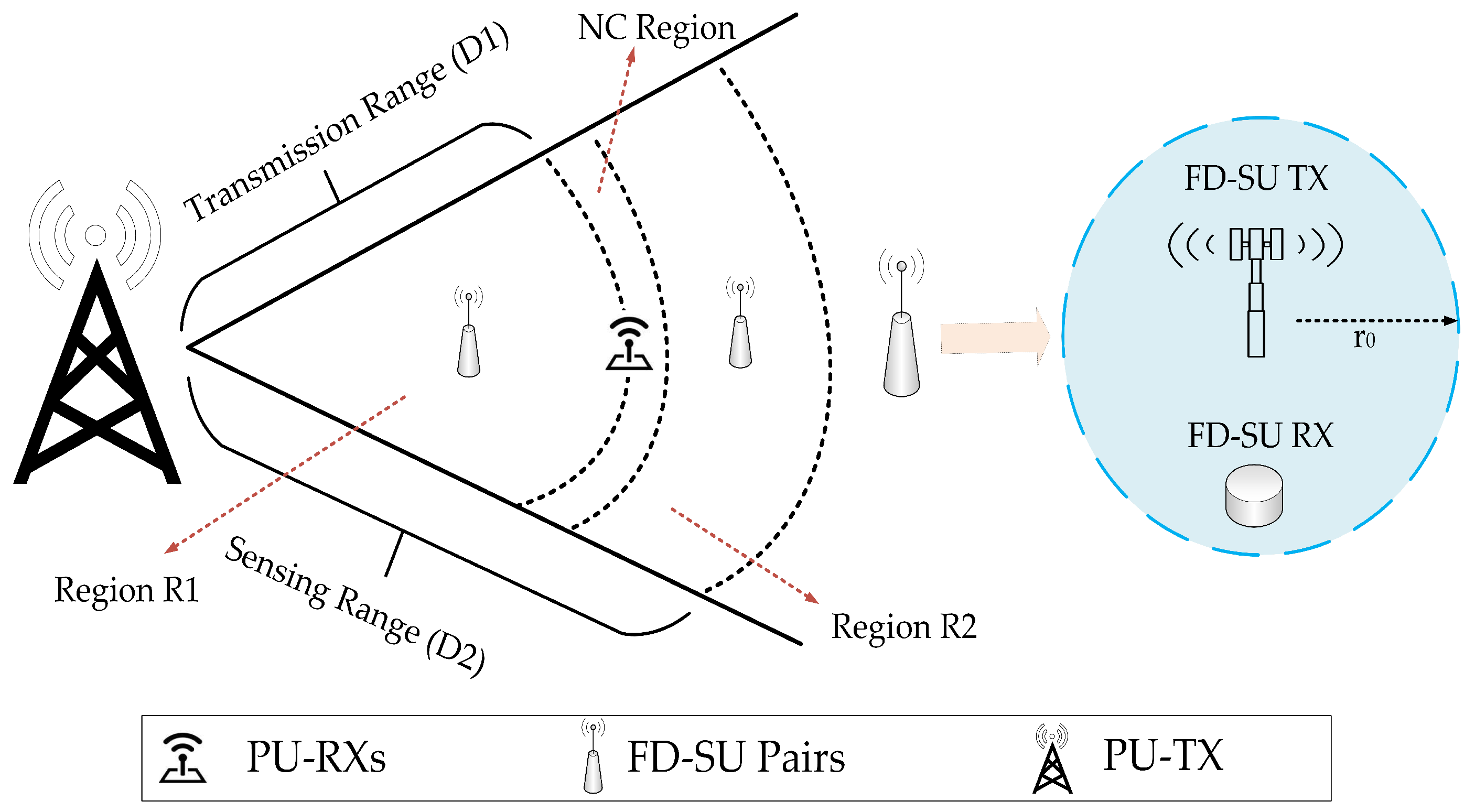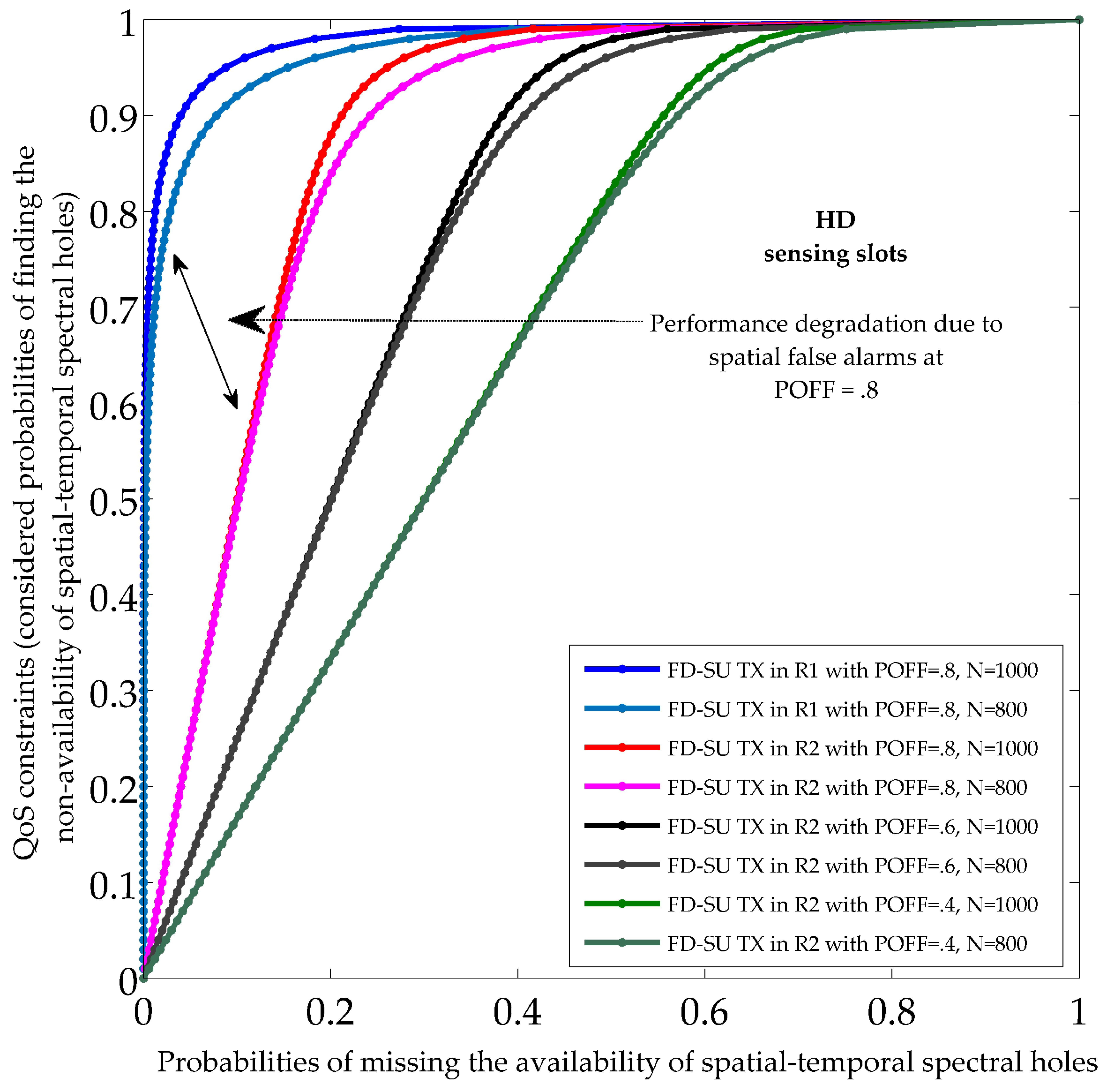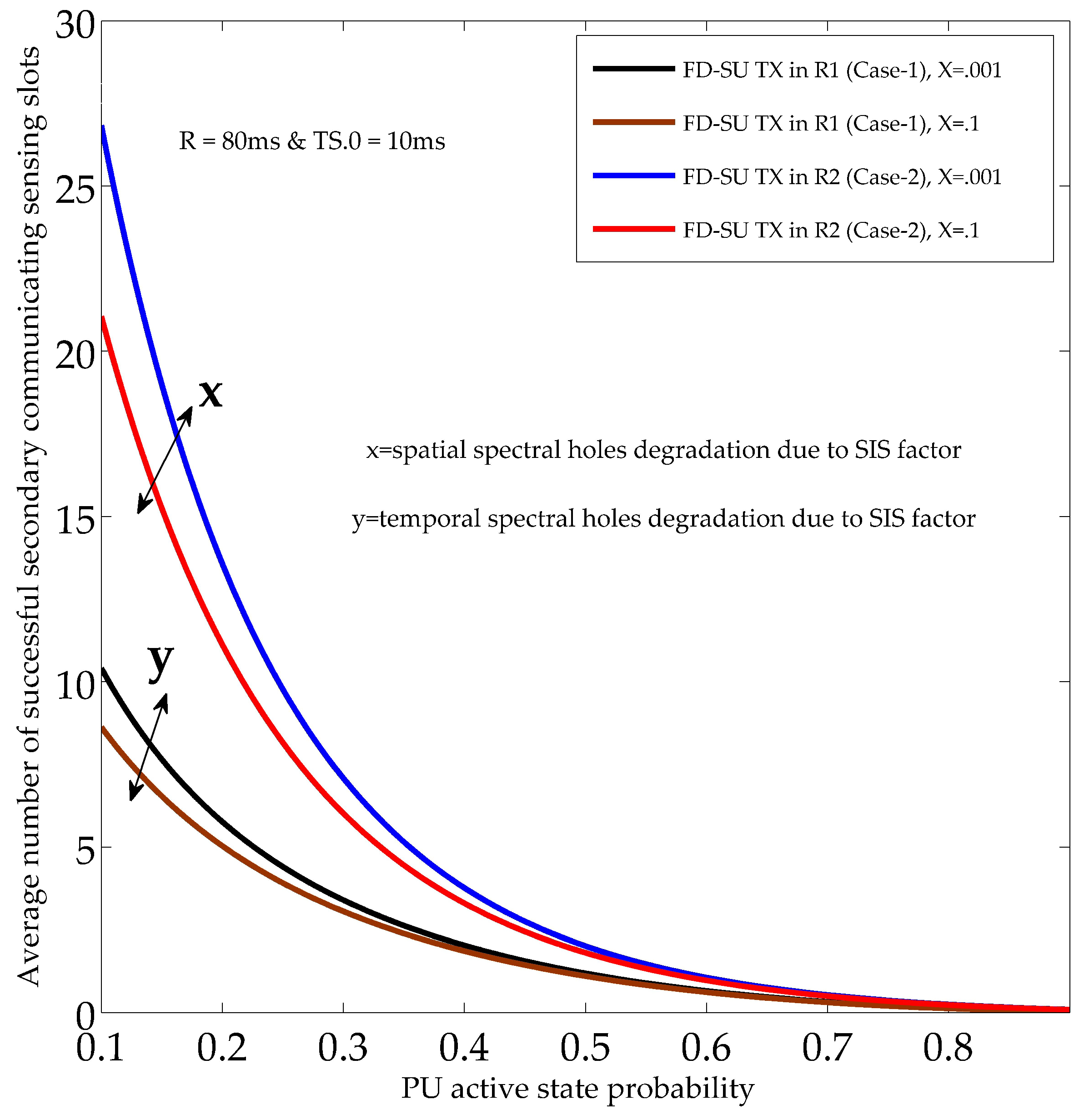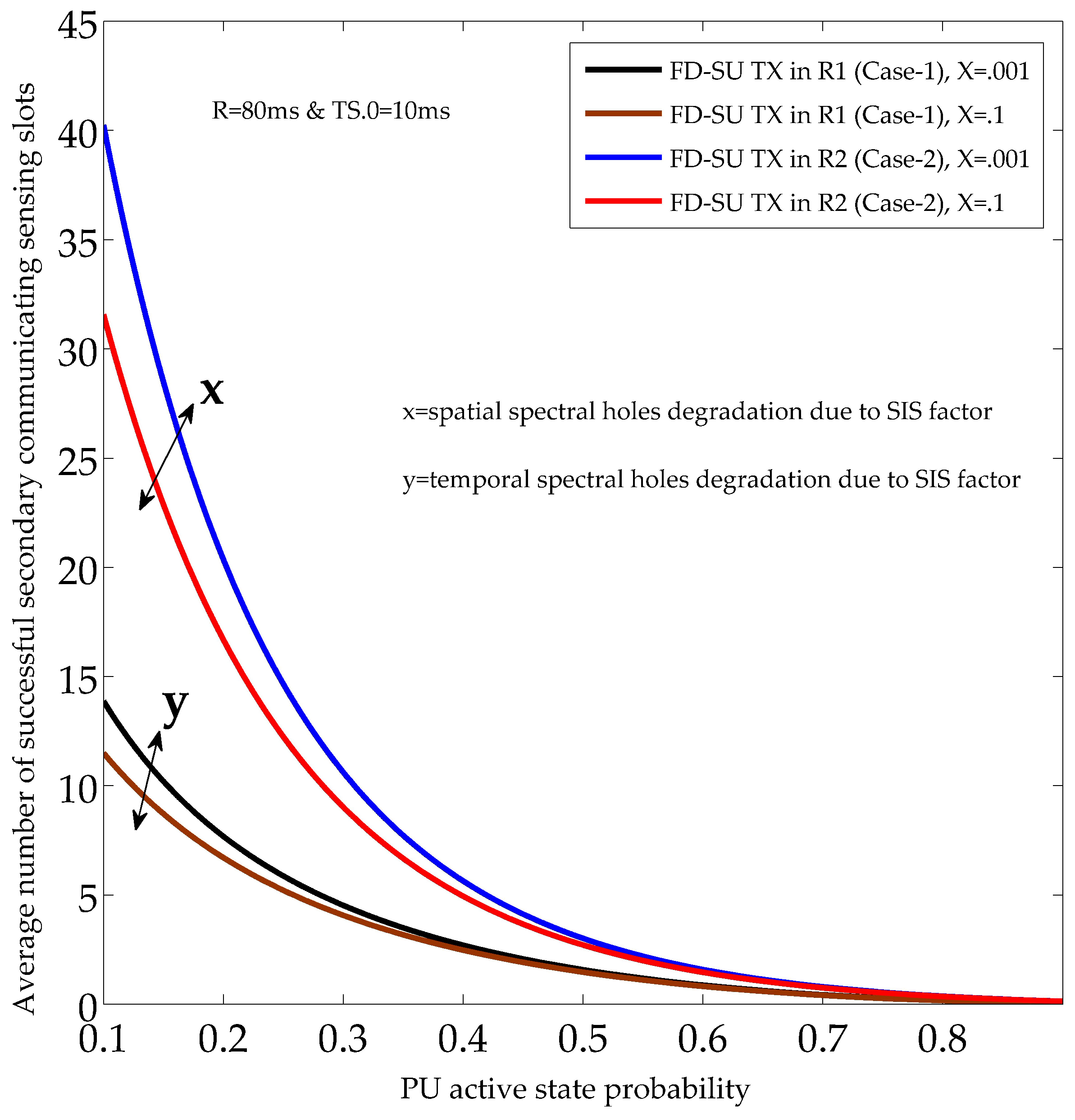Spatial–Temporal Sensing and Utilization in Full Duplex Spectrum-Heterogeneous Cognitive Radio Networks for the Internet of Things
Abstract
:1. Introduction
1.1. Motivations for Using SD-CRNs in IoT
1.2. Half Duplex (HD) and Full Duplex (FD) Radios
1.3. Main Contributions
- The realistic small-cell CR-IoT scenario is considered where FD-enabled SU transmitters (FD-SU TXs) with sensing capabilities are distributed randomly across the transmission region of primary network. Such a dense distribution of small-cell FD-SU TXs creates spectrum-heterogeneous environment with different spectral opportunities. In this regards, we propose a two-dimensional spatial–temporal spectral hole-sensing model for FD-SU TXs deployed in CR-IoT spectrum-heterogeneous environment, and incorporate the traffic variations of PU both in time and space domains.
- As a performance metric of the spatial–temporal sensing model, we propose and evaluate the probability of finding the non-availability of spatial–temporal spectral holes, and the probability of missing the availability of spatial–temporal spectral holes.
- Incorporating the proposed sensing model, we present an analytical formulation and evaluation of a UoS scheme for the FD-SU TXs present at different spatial positions. The performance of UoS scheme is investigated in terms of average number of sensing slots used for the successful secondary communication in each time-slotted frame.
1.4. Paper Organization
2. System Model
2.1. PU Spectrum Occupancy Model
2.2. Frame Structure of FD-SU TXs
3. Spatial–Temporal Spectral Hole-Sensing Model
- PU-TX is and FD-SU TX is not transmitting.
- PU-TX is and FD-SU TX is not transmitting.
- PU-TX is and FD-SU TX is transmitting.
- PU-TX is and FD-SU TX is transmitting.
4. Performance Metric for Spatial–Temporal Spectral Hole-Sensing Model
5. Utilization of Spectrum (UoS) Scheme
6. Results and Discussion
6.1. Simulation Setup
6.2. Simulation Results
7. Conclusions
Author Contributions
Funding
Conflicts of Interest
References
- Shafiq, M.; Ahmad, M.; Irshad, A.; Gohar, M.; Usman, M.; Afzal, M.K.; Choi, J.G.; Yu, H. Multiple access control for cognitive radio-based IEEE 802.11ah networks. Sensors 2018, 18, 43. [Google Scholar] [CrossRef] [PubMed]
- Wang, D.; Chen, D.; Song, B.; Guizani, N.; Yu, X.; Du, X. From IoT to 5G I-IoT: The next generation IoT-based intelligent algorithms and 5G technologies. IEEE Commun. Mag. 2018, 56, 114–120. [Google Scholar] [CrossRef]
- Salameh, H.A.B.; Almajali, S.; Ayyash, M.; Elgala, H. Spectrum assignment in cognitive radio networks for internet-of-things delay-sensitive applications under jamming attacks. IEEE Internet Things J. 2018, 5, 1904–1913. [Google Scholar] [CrossRef]
- Han, R.; Gao, Y.; Wu, C.; Lu, D. An Effective multi-objective optimization algorithm for spectrum allocations in the cognitive-radio-based internet of things. IEEE Access 2018, 6, 12858–12867. [Google Scholar] [CrossRef]
- Khalid, W.; Yu, H. Sum utilization of spectrum with spectrum handoff and imperfect sensing in interweave multi-channel cognitive radio networks. Sustainability 2018, 10, 1764. [Google Scholar] [CrossRef]
- Khalid, W.; Yu, H.; Zikria, Y.B. Improvement of spectrum utilization with retransmission in cognitive radio networks: Analytical approach. In Proceedings of the 9th International Congress on Ultra-Modern Telecommunications and Control Systems and Workshops (ICUMT), Munich, Germany, 6–8 November 2017; pp. 352–357. [Google Scholar]
- Ozger, M.; Akan, O.B. On the utilization of spectrum opportunity in cognitive radio networks. IEEE Commun. Lett. 2016, 20, 157–160. [Google Scholar] [CrossRef]
- Ejaz, W.; Ibnkahla, M. Multiband spectrum sensing and resource allocation for IoT in cognitive 5G networks. IEEE Internet Things J. 2018, 5, 150–163. [Google Scholar] [CrossRef]
- Baidya, S.; Levorato, M. Content-aware cognitive interference control for urban IoT systems. IEEE Trans. Cognit. Commun. Netw. 2018, 4, 500–512. [Google Scholar] [CrossRef]
- Li, T.; Yuan, J.; Torlak, M. Network throughput optimization for random access narrowband cognitive radio internet of things (NB-CR-IoT). IEEE Internet Things J. 2018, 5, 1436–1448. [Google Scholar] [CrossRef]
- Zhu, R.; Zhang, X.; Liu, X.; Shu, W.; Mao, T.; Jalaian, B. ERDT: Energy-efficient reliable decision transmission for intelligent cooperative spectrum sensing in industrial IoT. IEEE Access 2015, 3, 2366–2378. [Google Scholar] [CrossRef]
- Khan, A.A.; Rehmani, M.H.; Rachedi, A. Cognitive-radio-based internet of things: Applications, architectures, spectrum related functionalities, and future research directions. IEEE Wirel. Commun. 2017, 24, 17–25. [Google Scholar] [CrossRef]
- Liang, W.; Ng, S.X.; Hanzo, L. Cooperative overlay spectrum access in cognitive radio networks. IEEE Commun. Surv. Tutor. 2017, 19, 1924–1944. [Google Scholar] [CrossRef]
- Sharma, P.K.; Upadhyay, P.K.; Da Costa, D.B.; Bithas, P.S.; Kanatas, A.G. Performance analysis of overlay spectrum sharing in hybrid satellite-terrestrial systems with secondary network selection. IEEE Trans. Wirel. Commun. 2017, 16, 6586–6601. [Google Scholar] [CrossRef]
- Mehmeti, F.; Spyropoulos, T. Performance analysis, comparison, and optimization of interweave and underlay spectrum access in cognitive radio networks. IEEE Trans. Veh. Technol. 2018, 67, 7143–7157. [Google Scholar] [CrossRef]
- Khalid, W.; Yu, H. Optimal sensing performance for cooperative and non-cooperative cognitive radio networks. Int. J. Distrib. Sens. Netw. (IJDSN) 2017, 13, 1–9. [Google Scholar] [CrossRef]
- Hu, F.; Chen, B.; Zhu, K. Full spectrum sharing in cognitive radio networks toward 5G: A survey. IEEE Access 2018, 6, 15754–15776. [Google Scholar] [CrossRef]
- Deng, M.; Hu, B.; Li, X. Adaptive weighted sensing with simultaneous transmission for dynamic primary user traffic. IEEE Trans. Commun. 2017, 65, 992–1004. [Google Scholar] [CrossRef]
- Amjad, M.; Akhtar, F.; Rehmani, M.H.; Reisslein, M.; Umer, T. Full-duplex communication in cognitive radio networks: A survey. IEEE Commun. Surv. Tutor. 2017, 19, 2158–2191. [Google Scholar] [CrossRef]
- Liu, P.; Qi, W.; Yuan, E.; Wei, L.; Zhao, Y. Full-duplex cooperative sensing for spectrum-heterogeneous cognitive radio networks. Sensors 2017, 17, 1773. [Google Scholar] [CrossRef] [PubMed]
- Sabat, S.; Sharma, P.K.; Gandhi, A. Full-duplex cooperative spectrum sensing with primary user activity in cognitive radio networks. IETE Tech. Rev. 2017, 34, 4–14. [Google Scholar] [CrossRef]
- Tuan, P.V.; Koo, I. Throughput maximisation by optimising detection thresholds in full-duplex cognitive radio networks. IET Commun. 2016, 10, 1355–1364. [Google Scholar] [CrossRef]
- Bradonjic, M.; Lazos, L. Graph-based criteria for spectrum-aware clustering in cognitive radio networks. Ad Hoc Netw. 2012, 10, 75–94. [Google Scholar] [CrossRef]
- Khalid, W.; Yu, H. Optimal analysis for sum-utilization and sum-rate in cognitive radio networks with different PU activities. In Proceedings of the IEEE VTS Asia Pacific Wireless Communications Symposium (APWCS), Incheon, Korea, 23–25 August 2017. [Google Scholar]
- Sabat, S.; Gandhi, A.; Sharma, P.K. Cooperative spectrum sensing in full-duplex CRN with primary user activity. In Proceedings of the 10th International Conference on Communication Systems and Networks (COMSNETS), Bengaluru, India, 3–7 January 2018; pp. 410–413. [Google Scholar]
- Liao, Y.; Wang, T.; Song, L.; Han, Z. Listen-and-talk: Full-duplex cognitive radio networks. In Proceedings of the IEEE Global Communications Conference, Austin, TX, USA, 8–12 December 2014; pp. 3068–3073. [Google Scholar]
- Rehman, A.U.; Dong, C.; Yang, L.; Hanzo, L. Performance of cognitive stop-and-wait hybrid automatic repeat request in the face of imperfect sensing. IEEE Access 2016, 4, 5489–5508. [Google Scholar] [CrossRef]
- Afifi, W.; Krunz, M. Incorporating self-interference suppression for full-duplex operation in opportunistic spectrum access systems. IEEE Trans. Wirel. Commun. 2015, 14, 2180–2191. [Google Scholar] [CrossRef]
- Wu, Q.; Ding, G.; Wang, J.; Yao, Y. Spatial–temporal opportunity detection for spectrum-heterogeneous cognitive radio networks: Two-dimensional sensing. IEEE Trans. Wirel. Commun. 2013, 12, 516–526. [Google Scholar] [CrossRef]
- Ding, G.; Wang, J.; Wu, Q.; Song, F.; Chen, Y. Spectrum sensing in opportunity-heterogeneous cognitive sensor networks: How to cooperate? IEEE Sens. J. 2013, 13, 4247–4255. [Google Scholar] [CrossRef]
- Wang, J.; Ding, G.; Qihui, W.; Shen, L.; Song, F. Spatial-temporal spectrum hole discovery: A hybrid spectrum sensing and geolocation database framework. Chin. Sci. Bull. 2014, 59, 1896–1902. [Google Scholar] [CrossRef]
- Zhang, Z.; Wen, X.; Xu, H.; Yuan, L. Sensing nodes selective fusion scheme of spectrum sensing in spectrum-heterogeneous cognitive wireless sensor networks. IEEE Sens. J. 2018, 18, 436–445. [Google Scholar] [CrossRef]
- Al-Juboori, S.; Hussain, S.J.; Fernando, X. Cognitive spectrum sensing with multiple primary users in rayleigh fading channels. Electronics 2014, 3, 553–563. [Google Scholar] [CrossRef]
- Yu, H. Optimal primary pilot power allocation and secondary channel sensing in cognitive radios. IET Commun. 2016, 10, 487–494. [Google Scholar] [CrossRef]
- Rahman, M.A.; Lee, Y.; Koo, I. Joint relay selection and power allocation through a genetic algorithm for secure cooperative cognitive radio networks. Sensors 2018, 18, 3934. [Google Scholar] [CrossRef] [PubMed]










| Symbol | Description |
|---|---|
| Probability that the PU is in state | |
| Probability that the PU is in state | |
| R | Mean of durations |
| S | Mean of durations |
| A | Random variable for duration |
| B | Random variable for duration |
| T | Time-slotted frame length |
| N | Number of sensing samples in each sensing slot |
| Transmission region | |
| Sensing region | |
| Radius of transmission region | |
| Radius of sensing region | |
| X | SIS factor |
| Instantaneous sensing signal-to-noise ratio (SNR) | |
| Instantaneous interference-to-noise ratio (INR) | |
| SNR of secondary transmissions |
© 2019 by the authors. Licensee MDPI, Basel, Switzerland. This article is an open access article distributed under the terms and conditions of the Creative Commons Attribution (CC BY) license (http://creativecommons.org/licenses/by/4.0/).
Share and Cite
Khalid, W.; Yu, H. Spatial–Temporal Sensing and Utilization in Full Duplex Spectrum-Heterogeneous Cognitive Radio Networks for the Internet of Things. Sensors 2019, 19, 1441. https://doi.org/10.3390/s19061441
Khalid W, Yu H. Spatial–Temporal Sensing and Utilization in Full Duplex Spectrum-Heterogeneous Cognitive Radio Networks for the Internet of Things. Sensors. 2019; 19(6):1441. https://doi.org/10.3390/s19061441
Chicago/Turabian StyleKhalid, Waqas, and Heejung Yu. 2019. "Spatial–Temporal Sensing and Utilization in Full Duplex Spectrum-Heterogeneous Cognitive Radio Networks for the Internet of Things" Sensors 19, no. 6: 1441. https://doi.org/10.3390/s19061441
APA StyleKhalid, W., & Yu, H. (2019). Spatial–Temporal Sensing and Utilization in Full Duplex Spectrum-Heterogeneous Cognitive Radio Networks for the Internet of Things. Sensors, 19(6), 1441. https://doi.org/10.3390/s19061441






